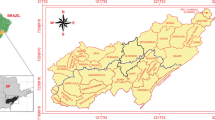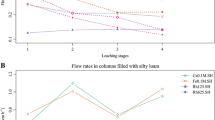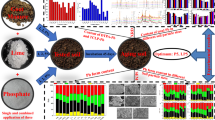Abstract
The effects of soil compaction on porosity (α), bulk density (ρs), and saturated hydraulic conductivity (Ksat) can create a physical barrier in the soil, reducing the vertical movement of toxic elements in the soil profile. However, the indirect effects of compaction in altering the forms and availability of heavy metals in soil have not been well-studied. This study examined the influence of compaction on forms of lead (Pb) in soils with contrasting texture. Four levels of compaction were imposed on a sandy loam and a clayey soil, which were artificially contaminated based on their maximum Pb adsorption capacity. Compaction had different effects on Pb forms depending on soil texture. In the sandy loam soil, compaction had a dual beneficial effect in mitigating the impact of Pb contamination, since it decreased Ksat, reducing metal transport to deeper soil layers, and also prevented transformation to more available Pb forms (soluble and exchangeable). Instead, there was an increase in the most environmentally stable forms of Pb (inner sphere adsorption on iron and manganese oxides). In the clayey soil, compaction caused a significant increase in soluble and exchangeable Pb, accompanied by a significant reduction in environmentally stable Pb (inner sphere adsorption on gibbsite and kaolinite). In addition, studies about Pb contents under compacted soil layers should be investigated, mainly in clayey soils with edible crops, and environmental remediation practices that involve the machines traffic (for example, phytoremediation—successive cultivation of Pb-hyperaccumulating plants) should be used with care to minimise the compaction of clayey soils.



Similar content being viewed by others
Data availability
Not applicable.
References
Al-Hamdan, A., & Reddy, K. R. (2005). Surface speciation modeling of heavy metals in kaolin: implications for electrokinetic soil remediation processes. Adsorption, 11, 529–546. https://doi.org/10.1007/s10450-005-5611-6.
Baveye, P. C., Otten, W., & Balseiro-Romero, M. (2018). Emergent properties of microbial activity in heterogeneous soil microenvironments: different research approaches are slowly converging, yet major challenges remain. Frontiers in Microbiology, 9, 1–48. https://doi.org/10.3389/fmicb.2018.01929.
Beiyuan, J., Awad, Y. M., Beckers, F., Tsang, D. C., Ok, Y. S., & Rinklebe, J. (2017). Mobility and phytoavailability of As and Pb in a contaminated soil using pine sawdust biochar under systematic change of redox conditions. Chemosphere, 178, 110–118. https://doi.org/10.1016/j.chemosphere.2017.03.022.
Cassel, D. K., & Nielsen, D. R. (1986). Field capacity and available water capacity. In A. Klute (Ed.), Methods of soil analysis. Part I. Physical and mineralogical methods, Chapter 36 (pp. 901–926). Madison: Soil Science Society of America. https://doi.org/10.2136/sssabookser5.1.2ed.c36.
Cavalieri, K. M. V., da Silva, A. P., Tormena, C. A., Leão, T. P., Dexter, A. R., & Håkansson, I. (2009). Long-term effects of no-tillage on dynamic soil physical properties in a Rhodic Ferrasol in Paraná, Brazil. Soil and Tillage Research, 103, 158–644. https://doi.org/10.1016/j.still.2008.10.014.
Chen, X., Liu, Y., Zhao, Q., Cao, W., Chen, X., & Zou, C. (2020). Health risk assessment associated with heavy metal accumulation in wheat after long-term phosphorus fertilizer application. Environmental Pollution, 262, 114348. https://doi.org/10.1016/j.envpol.2020.114348.
Ding, W., Liu, X., Hu, F., Zhu, H., Luo, Y., Li, S., & Li, H. (2019). How the particle interaction forces determine soil water infiltration: specific ion effects. Journal of Hidrology, 568, 492–500. https://doi.org/10.1016/j.jhydrol.2018.11.017.
Dotaniya, M. L., Dotaniya, C. K., Solanki, P., Meena, V. D., & Doutaniya, R. K. (2020). Lead contamination and its dynamics in soil–plant system. In D. K. Gupta, S. Chatterjee, & C. Walther (Eds.), Lead in Plants and the Environment, Radionuclides and Heavy Metals in the Environment (pp. 83–98). https://doi.org/10.1007/978-3-030-21638-2_5.
Duarte, A. P. A., Melo, V. F., Pauletti, V., & Brown, G. B. (2010). Changes in forms of lead and manganese with passage through the intestinal tract of Pontoscolex corethrurus (Oligochaeta: Annelida). 9th International Symposyum on Earthworm ecology. Xalapa: ISE, (1), 249–249. https://doi.org/10.1016/j.ejsobi.2012.08.004.
Elzinga, C. L., Salzer, D. W., Willoughby, J. W., & Gibbs, J. P. (2001). Monitoring plant and animal populations (p. 360). Great Britain: Blackwell Science, Inc..
Fontes, M. P. F., & Alleoni, L. R. F. (2006). Electrochemical attributes and availability of nutrients, toxic elements, and heavy metals in tropical soils. Scientia Agricola, 63, 261–269. https://doi.org/10.1590/S010390162006000600014.
Gee, G. W., & Bauder, J. W. (1986). Particle-size analysis. In A. Klute (Ed.), Methods of soil analysis: physical and mineralogical methods (Vol. 2, pp. 383–409). Madison: American Society of Agronomy.
Ghezzi, J., Karathanasis, A., Matocha, C., Unrine, J., & Thompson, Y. (2014). Competitive sorption behavior of arsenic, selenium, copper and lead by soil and biosolid nano- and macro-colloid particles. Open Journal of Soil Science, 4, 293–304. https://doi.org/10.4236/ojss.2014.49031.
Grossman, R. B., & Reinsch, T. G. (2002). Bulk density and linear extensibility. Methods of Soil Analysis. Part 4. Physical Methods. SSSA Book Series, 5, 201–228. https://doi.org/10.2136/sssabookser5.4.c9.
Gubiani, P. I., Reinert, D. J., & Reichert, J. M. (2006). Alternative method to measure the soil particle density–exactness, precision, and processing time. Rural Science, 36, 664–668. https://doi.org/10.1590/S0103-84782006000200049.
Gunten, K., Bishop, B., Zhang, L., Muehlenbachs, K., Alam, M. S., Konhauser, O., & Alessi, D. S. (2019). Biogeochemical behavior of metals along two permeable reactive barriers in a mining-affected wetland. JGR Biogeosciences, 124, 3536–3554. https://doi.org/10.1029/2019JG005438.
Hue, N. V., & Evans, C. V. (1986). Procedures used for soil and plant analysis by the Auburn University Soil Testing Laboratory. Auburn: Auburn Univ.
Ippolito, J. A., & Bjorneberg, D. L. (2013). Soil phosphorus availability differences between sprinkler and furrow irrigation. Western Nutrient Management Conference Proceedings, 10, 54–59.
Kabata-Pendias, A., & Pendias, H. (2001). Trace elements in soils and plants (3rd ed.p. 413). Boca Raton: CRC Press.
Keller, T., Sandin, M., Colombi, T., Horn, R., & Or, D. (2019). Historical increase in agricultural machinery weights enhanced soil stress levels and adversely affected soil functioning. Soil & Tillage Research, 194, 2–12. https://doi.org/10.1016/j.still.2019.104293.
Landefeld, L., Brandhuber, R., Fenner, S., Koch, H. J., & Stockfisch, N. (2004). Effects of agricultural machinery with high axle load on soil properties of normally managed fields. Soil & Tillage Research, 75, 75–86. https://doi.org/10.1016/S0167-1987(03)00154-5.
Ma, J., Lei, M., Weng, L., Li, Y., Chen, Y., Islam, M. S., Zhao, J., & Chen, T. (2019). Fractions and colloidal distribution of arsenic associated with iron oxide minerals in lead-zinc mine-contaminated soils: comparison of tailings and smelter pollution. Chemosphere, 227, 614–623. https://doi.org/10.1016/j.chemosphere.2019.04.030.
Mackey E. A., Christopher S. J., Lindstrom R. M., Long S. E., Marlow A. F., Murphy K. E. et al. (2010). Certification of three NIST renewal soil standard reference materials for element content: SRM 2709a San Joaquin Soil, SRM 2710a Montana Soil I, and SRM 2711a Montana Soil II. In: NIST Spec. Publ. 260–172, US Department of Commerce and National Institute of Standards and Technology.
Mazurana, M., Fink, J. R., Silveira, V. H., Levien, R., Zulpo, L., & Brezolin, D. (2013). Soil physical properties and maize root growth in an ultisol under controlled machine traffic. Revista Brasileira de Ciência do Solo, 37, 1185–1195. https://doi.org/10.1590/S010006832013000500008.
Meena, V., Dotaniya, M. L., Saha, J. K., Das, H., & Patra, A. K. (2020). Impact of lead contamination on agroecosystem and human health. In D. K. Gupta, S. Chatterjee, & C. Walther (Eds.), Lead in Plants and the Environment, Radionuclides and Heavy Metals in the Environment (pp. 67–82). https://doi.org/10.1007/978-3-030-21638-2_4.
Melo, V. F., Buschle, B., Souza, L. C. P., & Bonfleur, E. J. (2017). Reference values for potentially harmful elements in soils from Atlantic Rainforest, Brazil. Journal of Geochemical Exploration, 181, 138–147. https://doi.org/10.1016/j.gexplo.2017.07.009.
Menon, M., Jia, X., Lair, G. J., Faraj, P. H., & Blaud, A. (2015). Analysing the impact of compaction of soil aggregates using X-ray microtomography and water flow simulations. Soil & Tillage Research, 50, 147–157. https://doi.org/10.1016/j.still.2015.02.004.
Millan, E. R., Ruiz, H. A., Fernandes, R. B. A., & Costa, A. L. M. (2014). Hydraulic conductivity, porosity, mechanical resistance and least limiting water range in artificially compacted Oxisols. Revista Brasileira de Engenharia Agrícola e Ambiental, 10, 1003–1009. https://doi.org/10.1590/1807-1929/agriambi.v18n10p1003-1009.
Miranda, M. F. A., Freire, M. B. G. S., Almeida, B. G., Freire, A. G., Freire, F. J., & Pessoa, L. G. M. (2018). Improvement of degraded physical attributes of a saline-sodic soil as influenced by phytoremediation and soil conditioners. Archives of Agronomy and Soil Science, 64, 1207–1221. https://doi.org/10.1080/03650340.2017.1419195.
Mora, A., Jumbo-Flores, D., González-Merizalde, M., Bermeo-Flores, S. A., Alvarez-Figueroa, P., Mahlknecht, J., & Hernández-Antonio, A. (2019). Heavy metal enrichment factors in fluvial sediments of an Amazonian basin impacted by gold mining. Bulletin of Environmental Contamination and Toxicology, 102, 210–217. https://doi.org/10.1007/s00128-019-02545-w.
Mossadeghi-Björklund, M., Arvidssion, J., Keller, T., Koestel, J., Lamandé, M., Larsbo, M., & Jarvis, N. (2016). Effects of subsoil compaction on hydraulic properties and preferential flow in a Swedish clay soil. Soil and Tillage Reserarch, 156, 91–98. https://doi.org/10.1016/j.still.2015.09.013.
Novais, R. F., & Smyth, T. J. (1999). Fósforo em solo e planta em condições tropicais. 1ed. Viçosa: Universidade Federal de Viçosa. 103-104.
Ochoa, M., Tierra, W., Tupuna-Yerovi, D. S., Guanoluisa, D., Otero, X. L., & Ruales, J. (2020). Assessment of cadmium and lead contamination in rice farming soils and rice (Oryza sativa L.) from Guayas province in Ecuador. Environmental Pollution, 260, 114050. https://doi.org/10.1016/j.envpol.2020.114050.
Ohland, T., Lana, M. C., Frandoloso, J. F., Rampim, L., Bergmann, J. R., & Cabreira, D. T. C. (2014). Influence of soil density on the early growth of Jatrophacurcas L. cultivated in Oxisol. Revista Ceres, 61, 321–345. https://doi.org/10.1590/0034737X201461050004.
Palansooriya, K. N., Yang, G. Y., Tsang, Y. F., Sarkar, B., Hou, D., Cao, X., Meers, E., Rinklebe, J., Kim, K. H., & Ok, Y. S. (2019). Occurrence of contaminants in drinking water sources and the potential of biochar for water quality improvement: a review. Critical Reviews in Environmental Science and Technology, 50, 1–63. https://doi.org/10.1080/10643389.2019.1629803.
Palansooriya, K. N., Shaheen, S. M., Chene, S. S., Tsange, D. C. W., Hashimotof, Y., Houg, D., Bolanh, N. S., Rinklebeb, J., & Oka, Y. S. (2020). Soil amendments for immobilization of potentially toxic elements in contaminated soils: a critical review. Environment International, 134, 105046. https://doi.org/10.1016/j.envint.2019.105046.
Pires, L. F., Araújo Júnior, C. F., Dias, N. M. P., Dias Júnior, M. S., & Alacântara, E. N. (2017). Weed control methods effect on the hydraulic attributes of a Latosol. Acta Scientiarum Agronomy, 39, 119–128. https://doi.org/10.4025/actasciagron.v39i1.30814.
Poggere, G. C., Melo, V. F., Francelino, M. R., Schaefer, C. E., & Simas, F. N. (2015). Characterization of products of the early stages of pedogenesis in ornithogenic soil from Maritime Antarctica. European Journal of Soil Science, 67, 70–78. https://doi.org/10.1111/ejss.12307.
Poggere, G. C., Melo, V. F., Serrat, B. M., Mangrich, A. S., França, A. A., Corrêa, R. S., & Barbosa, J. Z. (2018). Clay mineralogy affects the efficiency of sewage sludge in reducing lead retention of soils. Journal of Environmental Science, 80, 45–57. https://doi.org/10.1016/j.jes.2018.07.017.
Pontoni, D., Freitas, M. V., Borgo, J., Stipp, R., & Bonfleur, E. J. (2020). Integrated assessment of the liquid and solid phases of lead-contaminated soils remediated with phosphate. Geoderma, 360, 113–119. https://doi.org/10.1016/j.geoderma.2019.113993.
Reynolds, W. D., & Elrick, D. E. (2002). Hydraulic conductivity of saturated soils, constant head method. In Methods of soil analyses, part 4, physical methods, Book Series 5 (pp. 694–700). Madison: Soil Science Society of America.
Rocha, E. R., Tzianabos, A. O., & Smith, C. J. (2007). Thioredoxin reductase is essential for thiol/disulfide redox control and oxidative stress survival of the anaerobe Bacteroides fragilis. Journal of Bacteriology, 189, 8015–8023. https://doi.org/10.1128/JB.00714-07.
SAS Institute (2000). SAS/STAT Guide for Personal Computer: Version 9.0. SAS Institute Inc., Cary.
Shaheen, S. M., & Rinklebe, J. (2014). Geochemical fractions of chromium, copper, and zinc and their vertical distribution in floodplain soil profiles along the central Elbe River, Germany. Geoderma, 229, 142–159. https://doi.org/10.1016/j.geoderma.2013.10.012.
Solgi, E., Sheikhzadeha, H., & Solgi, M. (2018). Role of irrigation water, inorganic and organic fertilizers in soil and crop contamination by potentially hazardous elements in intensive farming systems: case study from Moghan agro-industry, Iran. Journal of Geochemical Exploration, 185, 74–80. https://doi.org/10.1016/j.gexplo.2017.11.008.
Soracco, C. G., Lozano, L. A., Balbuena, R., Ressia, J. M., & Filgueira, R. R. (2012). Contribution of macroporosity to water flux of a soil under different tillage systems. Revista Brasileira de Ciência do Solo, 36, 49–55. https://doi.org/10.1590/S010006832012000400009.
United States Environmental Protection Agency - Usepa. SW-846 EPA Method 3052. (1996). Microwave assisted acid digestion of siliceous and organically based matrices. Test Methods for Evaluating Solid Waste. 3rd Update. Washington, DC: US Environmental Protection Agency.
Usiyama, T., & Fukushi, K. (2016). Predictive model for Pb (II) adsorption on soil minerals (oxides and low-crystalline aluminum silicate) consistent with spectroscopic evidence. Geochimica et Cosmochimica Acta, 190, 134–155. https://doi.org/10.1016/j.gca.2016.06.022.
Walkley, A., & Black, L. A. (1934). An examination of the Dgtjareff method for determining soil organic matter, and a proposed modification of the chromic acid titration method. Soil Science, 37, 29–38.
Wang, T., Sun, H., Mao, H., Zhang, Y., Wang, C., Zhang, Z., Wang, B., & Sun, L. (2014). The immobilization of heavy metals in soil by bioaugmentation of a UV-mutant Bacillus subtilis 38 assisted by NovoGro biostimulation and changes of soil microbial community. Journal of Hazardous Materials, 278, 483–490. https://doi.org/10.1016/j.jhazmat.2014.06.028.
Wang, T. Y., Lin, L., & L., & Tsai, Y. Z. (2016). Effect of gravel content on saturated hydraulic conductivity in sand. In H. Hazarika, M. Kazama, & W. Lee (Eds.), Geotechnical hazards from large earthquakes and heavy rainfalls (pp. 163–169). Tokyo: Springer. https://doi.org/10.1007/978-4-431-562054_15.
Wang, L., Chen, L., Tsang, D. C., Li, J. S., Baek, K., Hou, D., Ding, S., & Poon, C. S. (2018). Recycling dredged sediment into fill materials, partition blocks, and paving blocks: technical and economic assessment. Journal of Cleaner Production, 199, 69–76. https://doi.org/10.1016/j.jclepro.2018.07.165.
Yang, J., Mosby, D. E., Casteel, S., & Blanchar, R. W. (2001). Lead immobilization using phosphoric acid in a smelter contaminated urban soil. Environmental Science and Technology, 35, 3553–3559. https://doi.org/10.1021/es001770d.
Zanello, S., Melo, V. F., & Nagata, N. (2018). Study of different environmental matrices to access the extension of metal contamination along highways. Environmental Science and Pollution Research, 25, 5969–5979. https://doi.org/10.1007/s11356-017-0908-z.
Zhao, Q., Hyunwook, C., Aditya, B., Burns, S. E., & Bate, B. (2016). Review of the fundamental geochemical and physical behaviors of organoclays in barrier applications. Applied Clay Science, 77, 3–19. https://doi.org/10.1016/j.clay.2016.11.024.
Zulfiqar, U., Farooqa, M., Hussain, S., Maqsood, M., Hussain, M., Ishfaq, M., Ahmad, M., & AnjumM.Z. (2019). Lead toxicity in plants: impacts and remediation. Journal of Environmental Management, 250, 109557.
Acknowledgements
The authors are grateful to Professor Neyde Fabiola Balarezo Giarola from Ponta Grossa State University for indicating and providing the soil collecting for this research.
Funding
This study was financially supported by CAPES (Coordenação de Aperfeiçoamento de Pessoal de Nível Superior in Brazil) (scholarship for the first author).
Author information
Authors and Affiliations
Contributions
Not applicable.
Corresponding author
Ethics declarations
Conflict of interest
Not applicable.
Code availability
Not applicable.
Additional information
Publisher’s note
Springer Nature remains neutral with regard to jurisdictional claims in published maps and institutional affiliations.
Rights and permissions
About this article
Cite this article
de Campos, A.K.R., Cavalieri-Polizeli, K.M.V. & Melo, V.d.F. Effects of compaction on lead availability in contaminated soils with contrasting texture. Environ Monit Assess 192, 672 (2020). https://doi.org/10.1007/s10661-020-08648-w
Received:
Accepted:
Published:
DOI: https://doi.org/10.1007/s10661-020-08648-w




